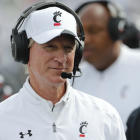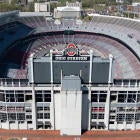USA Today came out Wednesday with its annual, terrific college football coaches' database. One of the more eye-opening numbers was that seven coaches would be owed at least $20 million if they are fired in December for losing too many games.
The lesson: Star coaches who can generate revenue have incredible leverage in contract negotiations these days. Just like coaches' salaries continue to skyrocket -- there are 20 coaches making at least $4 million in 2016 compared to none 10 years ago -- so do buyouts.
"There's such tremendous pressure to generate revenues and win that basically these universities are sort of bending over contractually to get these coaches in the door," sports attorney Martin Greenberg told USA Today. "Euphoria sometimes overtakes objectivity and intelligence."
Nick Saban changed the salary market in 2007 when Alabama made him the first $4-million-a-year coach. But another coach from Alabama changed the buyout market.
The rampant increase in buyouts can be traced back to Auburn's JetGate scandal in 2003, when the Tigers were prepared to spend $4 million to fire Tommy Tuberville and hire Bobby Petrino. Paying $4 million to someone to not coach was unheard of at the time.
In the early 2000s, there were buyouts exceeding $1 million to Georgia's Jim Donnan ($2.4 million), Ohio State's John Cooper ($1.8 million) and UCLA's Bob Toledo ($1.3 million). But the vast majority of buyouts were below $1 million and nowhere near the $4 million Auburn would have spent until its secret meeting with Petrino became public.
Tuberville survived, but the knowledge that a school was willing to spend $4 million to fire a coach created a ripple effect. Clemson's Tommy Bowden also saved his job in 2003 and renegotiated a deal so his buyout increased from $750,000 to $3 million.
When Auburn went undefeated in 2004, Tuberville's name was briefly linked to the vacant LSU job eventually filled by Les Miles. (Agents aren't dumb and know how to get more job security for their coaches.) That allowed Tuberville's contract to be renegotiated and his buyout increased to $7 million. By the time Auburn fired Tuberville in 2008, his buyout was still $6 million.
Tuberville's landmark $4 million buyout in 2003 would be the equivalent of $5.2 million in 2016 when factoring inflation. Today, Tuberville's 2003 buyout would rank 42nd among FBS coaches in the USA Today database and behind Middle Tennessee coach Rick Stockstill.
The highest buyouts in 2016 (some of the contracts include language in which the amount can be reduced):
- Jimbo Fisher, Florida State: $33.1 million
- Urban Meyer, Ohio State: $27.4 million
- Jim Harbaugh, Michigan: $25.6 million
- Kirk Ferentz, Iowa: $25.3 million
- Bob Stoops, Oklahoma: $24.8 million
- Nick Saban, Alabama: $23.3 million
- Dabo Swinney, Clemson: $20 million
- Lovie Smith, Illinois: $19.3 million
- Chris Petersen, Washington: $16.4 million
- Kevin Sumlin, Texas A&M: $15.4 million
If Texas fires Charlie Strong, who is 14-18 in three seasons, he would be owed more than $11.2 million. According to USA Today, Strong's predecessor, Mack Brown, never had a potential buyout larger than $3.5 million between 1998 and 2013.
Should Oregon decide to fire Mark Helfrich, he would be owed $11.6 million. Kentucky's Mark Stoops would be owed $14 million if he's fired. The Illini's Smith is in no danger of being fired. But he hasn't coached in college since 1995, and if he falters, his buyout with football-starved Illinois would start at $19.3 million (eighth in the country).
No one gets sweetheart buyouts like Ferentz, who would be owed $25 million if fired now. Ferentz got new contract terms after nearly winning the Big Ten and reaching the Rose Bowl in 2015. But he has averaged about seven wins per year in 17 seasons, and Iowa has a disappointing 5-3 record in 2016.
USA Today noted that Kansas dramatically changed its buyout structure for David Beaty after paying three coaches not to coach. Charlie Weis still has more than $5.4 million owed to him by Kansas. Beaty's buyout would only be $1.6 million.
The success by coaches undoubtedly helps produce revenue, which continues to increase in the multibillion-dollar college football industry. Still, it's disheartening to see a remark like this from agent Neil Conrich, who represents Bob Stoops and Ferentz:
"He noted that 'coaches are the people who are producing the revenue' and their compensation reflects 'the value being added and the very few people who can consistently add that value.'"
Tell that to the players who are on the field producing wins.
The bottom line: Coaches are in the drivers' seat. There are so few truly elite head coaches a school can bank on for success that they will hand out sweetheart deals based on potential or the first glimpse of success.
Universities have fewer problems these days blinking to pay the exorbitant buyout figures. There's so much more money at stake and available for buyouts that these payouts can come sooner and sooner.
Coaches everywhere can thank Tuberville, whose future at Cincinnati now may rest on this season's final five games. On Oct. 1, more than five months after Cincinnati announced it had committed to keep Tuberville through at least 2019, Tuberville signed a two-year contract extension. Tuberville would receive $2.4 million if he's fired this season, more than double his previous buyout, the Cincinnati Enquirer reported. In exchange, The Enquirer reported Tuberville will receive $70,000 less for the 2016 calendar year and $60,000 less for 2017.
No one plays the buyout game quite like Tuberville. He should know. He and Auburn helped start it.





















